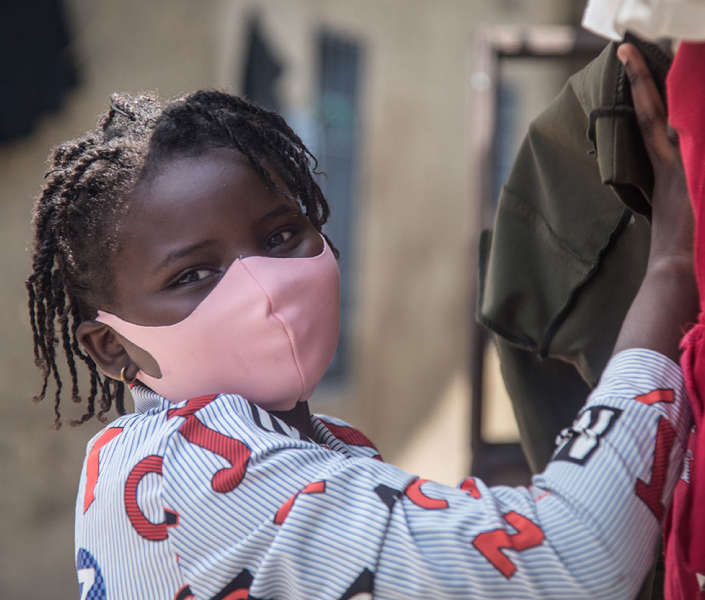Progress report African region 21 - Executive Summary

The COVID-19 crisis has permanently altered the global health landscape, even as African countries continue to battle multiple, complex humanitarian crises, shutdowns of health programmes and clinical services, pandemic fatigue, an exhausted workforce, and the economic fallout. By the end of July 2021, the WHO African Region was in the throes of the third wave of the virus, with reported cases surpassing the six million mark. It was the shortest period of resurgence since the pandemic began.
This report shines a spotlight on the efforts undertaken by WHO in the African Region (WHO-AFR) in collaboration with its partners, between February and July 2021, to support Member States to prevent, respond to, and mitigate the spread of the coronavirus (SARS-CoV-2). It lays considerable emphasis on preparations for mass vaccination rollouts, as new variants of the virus expanded. The latest virus resurgence – the third wave – followed a period of calm, which had enabled WHO-AFR and its partners to engage in several important prevention, mitigation and adaptation measures. Organized in a coordination structure, with 11 technical pillars, an information network attached to its global presence, 47 country offices in Africa, and strong partnerships, the COVID-19 response under the COVID-19 SPRP 2021 builds upon the experience of the first year of the global pandemic response, and previous epidemics or pandemics.
Deploying 302 specialists to 46 countries, and reallocating part of its 1400-strong workforce, WHO-AFR worked to strengthen national and subnational multisectoral coordination mechanisms. On training alone, 45 countries received instruction for 200 000 health workers on infection prevention and control, border control, treatment, logistics, laboratory testing and risk communication. Specifically, to improve procurement mechanisms, 15 countries undergoing resurgence were targeted regarding procurement and supply chain practices for oxygen and other medical supplies. Strengthening surveillance was also a priority, and 31 countries benefitted from multidisciplinary workshops on points of entry and cross-border collaboration.
Targeting another critical requirement for creating local and context-specific solutions for prevention and control responses, WHO-AFR focused on community inclusion in the response, building up programmes in community social and behaviour change, and infodemic management. For example, 345 000 front-line community health workers received training on COVID-19 symptoms, referral and – with the issue of long COVID-19 looming – psychosocial support. WHO-AFR encouraged countries to compile and manage data, and by the end of the reporting period, 85% of the countries had submitted data on laboratory testing. In the area of supplies, with a budget of US$ 169.3 million, WHO-AFR procured US$ 21.3 million worth of diagnostic materials and equipment, including 15 million antigen tests, one million GeneXpert tests, 3.7 million PCR tests, and 32.4 PPE suits, in addition to 532 oxygen concentrators, 392 patient monitors, and 412 pulse monitors, among others.
Among several studies conducted to better understand the extent of disruptions to essential health services caused by the COVID-19 pandemic, in early 2021, WHO launched the second round of the National pulse survey on continuity of essential health services during the COVID-19 pandemic. The findings showed that health services remained interrupted in 37 countries, even when virus infection numbers were waning. Also in the past six months, a database of more than 1000 technological innovations for COVID-19 was created to improve access to information on new approaches and tools. Intra-action reviews (IARs) were conducted in 20 countries; they constituted a collective learning exercise based on shared experiences and challenges and bottleneck recognition, which informed the updating of response plans and strengthened response structures.
With vaccinations reaching less than 1.5% of the WHO African Region by 31 July, more vaccine candidates and manufacturing sites were added for approval by WHO for emergency use listing, and the COVAX Facility was confident of its capacity to deliver 520 million doses to Africa by the end of 2021Partially resulting from WHO AFR’s continuing advocacy efforts, the African Union announced plans to start delivering 400 million Johnson & Johnson doses it procured on behalf of African countries. Moreover, South Africa in May announced a vaccine manufacturing operation in a public-private partnership with Pfizer to produce 400 million doses of vaccines by 2022. Albeit working with a 70% funding gap for 2021 – a total US$ 155.2 million as of 31 July -, WHO AFR built on gains from 2020, and supported increased efficiencies among countries, assisting Member States to budget for the right thing, at the right amount. The budgetary shortfall had a profound effect on health system continuity, with countries having to choose between routine vaccination and primary health care and preventing COVID-19. It also affected the Region’s capacity to procure and administer vaccines in a timely and consistent manner, and by the end of July less than 1.5% of the entire continent of 1.3 billion people had received a full immunization course against COVID-19.
The WHO-AFR COVID-19 response for the first part of this year benefitted from several key lessons regarding coordination. This was especially true in case management, where procurement, distribution and local production of oxygen took on added importance during the last four weeks of July, given a steep rise in case fatality ratios. In this regard, WHO-AFR facilitated dialogue between the public and private sectors in and among countries to increase access to high-quality oxygen, and other medical supplies. Where the absence of protocols and legislation delayed use of oxygen for treatment, for example, WHO-AFR worked with countries to ensure increased agility and establish simple effective treatment and equipment protocols.
The work conducted under the COVID-19 SPRP 2021 reveals the need for a continued country-focused, context-specific response based on lessons learnt-, backstopped by a comprehensive approach centred on primary care, recognizing that no single intervention taken in isolation will bring the pandemic to an end. Public health and safety measures, the response capacity at the primary care level, the progressive expansion of hospital services including Emergency Medical Teams (EMTs) and vaccination should be undertaken together.




